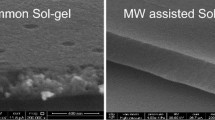Abstract
Optically transparent, ca. 200–800 nm thick TiO2-hydroxypropylcellulose (HPC) hybrid thin films were prepared from Ti(OC3H i7 )4–HPC–HCl–H2O–C3H i7 OH solutions by the sol–gel method, where the as-deposited films were dried at 120 °C. The effects of the amount of HPC, H2O and HCl in the starting solutions on the refractive index and uncracking critical thickness of the films were studied, where the effects on the critical thickness was discussed on the basis of in situ stress measurements during heating. The increase in HPC content increased the critical thickness and lowered the refractive index. The increase in HCl content resulted in a decrease in critical thickness and an increase in refractive index. Larger H2O contents gave rise to a maximum in critical thickness while the refractive index was unaffected. Such variation in critical thickness with varying solution compositions was demonstrated to result from the differences in in-plane stress generated during heating. By optimizing the processing parameters an 810 nm thick TiO2–HPC hybrid film of a refractive index of 1.84 was obtained.














Similar content being viewed by others
References
Lü C, Yang B (2009) J Mater Chem 19:2884–2901
Kim JS, Yang SC, Bae BS (2010) Chem Mater 22:3549–3555
Nagpal VJ, Davis RM (1995) J Mater Res 10:3068–3078
Kusabe M, Kozuka H, Abe S, Suzuki H (2007) J Sol Gel Sci Technol 44:111–118
Halamus T, Wojciechowski P, Bobowska I (2008) Polym Adv Technol 19:807–811
Halamus T, Wojciechowski P (2007) Polym Adv Technol 18:411–417
Zhao G, Tian Q, Liu Q, Han G (2005) Surf Coat Technol 198:55–58
Mont FW, Kim JK, Schubert MF, Schubert EF, Siegel RW (2008) J Appl Phys 103:083120
Chau JLH, Lin YM, Li AK, Su WF, Chang KS, Hsu SLC, Li TL (2007) Mater Lett 61:2908–2910
Liu Y, Lu C, Li M, Zhang L, Yang B (2008) Colloids Surf. A Physicochem Eng Asp 328:67–72
Lee LH, Chen WC (2001) Chem Mater 13:1137–1142
Su HW, Chen WC (2008) Macromol Chem Phys 209:1778–1786
Liou GS, Lin PH, Yen HJ, Yu YY, Chen WC (2010) J Polym Sci A Polym Chem 48:1433–1440
Liou GS, Lin PH, Yen HJ, Yu YY, Tsai TW, Chen WC (2010) J Mater Chem 20:531–536
Nakayama N, Hayashi T (2007) J Appl Polym Sci 105:3662–3672
Xiong M, Zhou S, You B, Wu L (2004) J Polym Sci B Polym Phys 43:637–649
Wang F, Luo Z, Qing S, Qiu Q, Li R (2009) J Alloy Comp 486:521–526
Ochi M, Nii D, Suzuki Y, Harada M (2010) J Mater Sci 45:2655–2661
Sorek Y, Zevin M, Reisfeld R (1997) Chem Mater 9:670–676
Bobowska I, Wojciechowski P, Halamus T (2008) Polym Adv Technol 19:1860–1867
He Y, Wang JA, Pei CL, Song JZ, Zhu D, Chen J (2010) J Nanopart Res 12:3019–3024
Pal E, Sebok D, Hornok V, Dekany I (2009) J Colloid Interface Sci 332:173–182
Iwasaki M, Kashimura K, Masaki H, Ito S (2003) J Sol Gel Sci Tecnol 26:389–392
Ribeiro SJL, Messaddeq Y, Goncalves RR, Ferrari M, Montagna M, Aegerter MA (2000) Appl Phys Lett 77:3502–3504
Stoney GG (1909) Proc R Soc Lond A 82:172–175
Brantly WA (1973) J Appl Phys 44:534–535
Kozuka H (2006) J Sol Gel Sci Technol 40:287–297
Look JL, Zukoski CF (1992) J Am Ceram Soc 75:1587–1595
Author information
Authors and Affiliations
Corresponding author
Rights and permissions
About this article
Cite this article
Oda, S., Uchiyama, H. & Kozuka, H. Sol–gel-derived titania-hydroxypropylcellulose hybrid thin films of high refractive indices: solution components affecting the refractive index and uncracking critical thickness. J Sol-Gel Sci Technol 61, 484–493 (2012). https://doi.org/10.1007/s10971-011-2649-7
Received:
Accepted:
Published:
Issue Date:
DOI: https://doi.org/10.1007/s10971-011-2649-7




